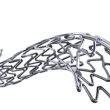Severe aortic regurgitation (AR) may account for 20% to 30% of all surgical aortic valve replacements (SAVR) and is often associated with aortic stenosis (AS). Transcatheter treatment of these patients is limited due to anatomical factors such as root and annular dilation, large annular dimensions, and less calcification in the valve leaflets to serve as...
Calcified Nodules and the Importance of OCT Categorization prior PCI
TLR associated factors in patients with calcified nodules. Patients with complex cardiomyopathies undergoing percutaneous coronary intervention are increasingly common, as is the case for calcified lesions and calcified nodules (CN). Procedure complexity not only involves planning, but also establishing patient prognosis, taking into consideration the fact that most target vessel events occur at long term...
TAVI in Moderate Aortic Stenosis with Low Ejection Fraction
The presence of aortic stenosis, heart failure, and decreased ventricular function is associated with poor prognosis and high mortality. For this reason, both European and American guidelines classify severe stenosis as a Class I indication. There are two retrospective analyses that demonstrate the benefits of transcatheter aortic valve implantation (TAVI) via transfemoral access. The TAVR...
Minimal Stent Area: New IVUS Parameter?
Intravascular Ultrasound (IVUS) has shown, in several studies, its great benefits for both restenosis and mortality reduction. Even though several variables have been studied, so far minimal stent area (MSA) has been disregarded as important. The OPTIVUS-Complex PCI looked at 961 patients with 1,957 lesions, and found 1.6% TLR incidence (30 lesions). There were no...
Frequency and Causes of Mortality in Chronic Total Occlusion
In recent years, there has been an increase in the number of percutaneous coronary interventions (PCI) performed to treat chronic total occlusion (CTO). This increase is due to the availability of more advanced technology and greater experience of both operators and specialized centers. However, it is important to note that this technique is not free...
Invasive vs Conservative Treatment in Patients with Spontaneous Coronary Artery Dissection
The prevalence of spontaneous coronary artery dissection (SCAD) is around 4% of acute coronary syndromes (ACS). Even though the current guidelines recommend a conservative approach, as long as it is clinically viable, it remain unclear whether there are benefits to percutaneous coronary intervention (PCI) as an initial approach, to prevent disease progression and adverse events....
Diffuse Coronary Artery Disease: One-Year 48mm XIENCE Skypoint Outcomes
Long 48mm Stent XIENCE Skypoint in the treatment of diffuse CAD Long coronary artery lesions often involve complex decision making since they can be treated either with a long stent or with shorter overlapping stents. Both in registries and meta-analysis, the overlapping technique has been associated to increased target vessel revascularization and increased radioscopy time,...
TAVR: Does HALT Affect Follow-Up?
Transcatheter aortic valve replacement (TAVR) in low-risk patients has been shown to be superior or noninferior in randomized studies, but the presence of valvular thrombosis, in its different forms, has not been well analyzed, nor is there much information on its impact on evolution. Researchers conducted an analysis of the LTR study that included 200...
Mitral Valve Surgery after Edge-to-Edge Repair
In last few years, transcatheter edge-to-edge repair (TEER) with MitraClip has been shown safe and effective, both for primary and secondary mitral valve regurgitation (MR), given the increasing interventionist and echocardiographer experience. However, there is a group of patients that require surgery after failed TEER, either because of bad evolution or because device implantation...
Impact of Right Ventricular Pacing in Patients with Permanent Pacemaker Implantation after TAVR
Permanent pacemaker implantation (PPI) is a relevant complication in patients undergoing transcatheter aortic valve replacement (TAVR) despite there being new devices. The current information on the long term impact of this complication remains unclear and recent evidence suggests post-TAVR ventricular pacing (VP) might be associated to higher risk of all-cause mortality and hospitalization for cardiac...









